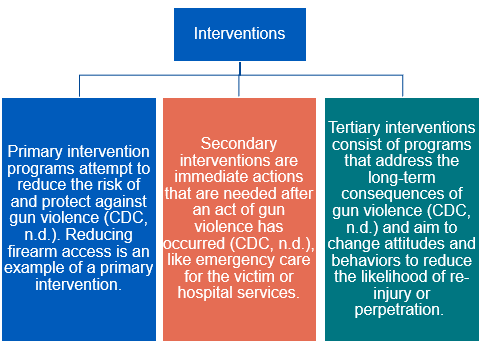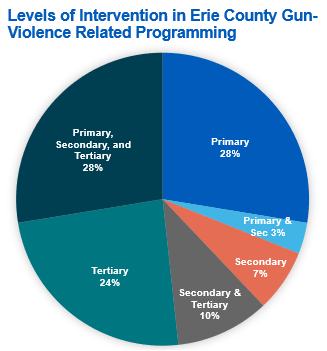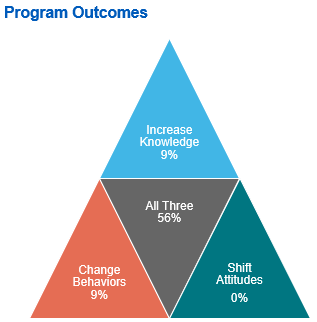Produced by University at Buffalo School of Social Work - Spring 2023
Mickey Sperlich, Patricia Logan-Greene, Christopher St. Vil, Denise Lillvis, Ogechi Kalu, & Rebecca Rasnake
Poster Summary [PDF]
Research literature related to community gun violence prevention is sparse. To address the escalating nature of this problem in Erie County, an environmental scan was conducted of all agencies with related programming. We identified 97 organizations, and 29 representatives completed interviews. Information was gathered about the populations served, funding sources, program design, intended outcomes, staffing, and the role in addressing gun violence. Funding varied widely from non to multi-million-dollar budgets. Programs typically approached gun violence comprehensively, with even distribution among primary, secondary, and tertiary prevention categories. Half of the programs specifically served the City of Buffalo and the other half served all or other areas of Erie County. Most programs were aimed at youth and there were fewer services for adults. These findings were elicited by local experts to guide potential interventions and a report has been given to the Erie County Task Force.
- Americans own 46% of the world’s privately owned firearms (Fox et al., 2021).
- From 1996 to 2018, federally funded gun research was prohibited (Rostron, 2018), contributing to a lack of evidence-based interventions.
- In 2017, there were 109 firearm deaths per day (Amnesty International, 2021).
- In 2020, there were 358 people injured by firearms and 46 deaths in Buffalo (New York State, 2021).

Key Findings
- Programs depicted a broad spectrum of funding, from self-funded non-profit programs to multi-million-dollar budgets.
- 35% of programs were in Buffalo and about half were spread throughout the county.
- Most programs focused on a combination of changing behavior, increasing knowledge, and shifting attitudes related to gun violence.
- Most programs did not explicitly focus on reducing gun violence as a program objective, but their services indirectly addressed the issue.
- 35% of interviewees reported that gun violence survivors held positions in their organizations.


Limitations
The polarizing view of gun ownership, debates about gun access, the distressing relationship between law enforcement and communities of color, and agency hardships due to COVID all present challenges to this type of research. There were a few key individuals that were unresponsive who we believe could contribute further to the discussion of gun violence in Erie County.
Future Directions
The Erie County Task Force will utilize findings from the scan to identify interventions on a county level and allocate funding. Half of the individuals interviewed stated they were willing to speak with the task force to further support the identification of appropriate responses to gun violence.
Researchers received IRB approval to conduct more in-depth interviews and many interviewees agreed to participate. They provided their perspectives on what is causing gun violence in Erie County and thoughts/suggestions on how to approach reducing gun violence. These responses are currently being analyzed. Findings will be reported to the task force and submitted for peer-reviewed publication.
References
Amnesty International. (2021, April 19). Gun Violence - Key Facts. Amnesty International. Retrieved June 30, 2022, from https://www.amnesty.org/en/what-we-do/arms-control/gun-violence
Centers for Disease Control and Prevention. (2022, May 10). Firearm deaths grow, disparities widen. Centers for Disease Control and Prevention. Retrieved June 30, 2022, from https://www.cdc.gov/media/releases/2022/s0510-vs-firearm-deathrates.html
Centers for Disease Control and Prevention. (n.d.). Principles of Prevention Guide. Veto Violence. Retrieved July 1, 2022, from https://vetoviolence.cdc.gov/apps/pop/assets/pdfs/pop_notebook.pd
Fox, K., Shveda, K., Croker, N., & Chacon, M. (2022, May 26). How US gun culture stacks up with the world. CNN. Retrieved June 30, 2022, from https://www.cnn.com/2021/11/26/world/us-gun-cultureworld-comparison-intl-cmd/index.html
New York State. (2021, May). Gun involved violence elimination (give) initiative violent ... - NY DCJS. ny.gov. Retrieved July 1, 2022, from https://www.criminaljustice.ny.gov/crimnet/ojsa/GIVE%20VCBF%20and20%Shooting%20Activity%20Re port.pdf
Rostron A. (2018). The Dickey Amendment on federal funding for research on gun Violence: A legal dissection. American Journal of Public Health, 108(7), 865–867. https://doi.org/10.2105/AJPH.2018.304450
Sperlich, M., Logan-Greene, P., St. Vil, C., & Lillvis, D. (2023). Final report: Erie County gun violence prevention environmental scan. University at Buffalo.